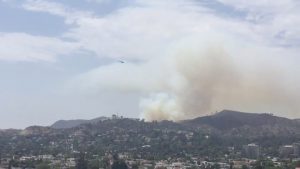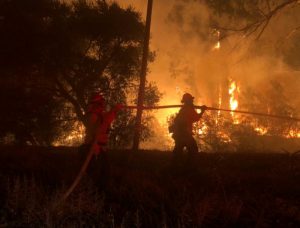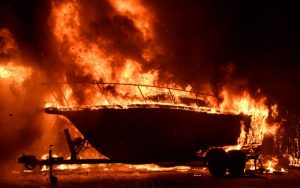
By Andrew Hay
TAOS, New Mexico (Reuters) – Bigger and more “explosive” wildfires are raging across the U.S. West, with the area burned in Colorado already four times the size of last year’s total, as rising temperatures, drought and a buildup of forest fuels supercharge blazes.
So far this year, 3.3 million acres have burned in U.S. forests, just below the figure for this time in 2017. Last year was the second worst year on record with 10 million acres blackened, according to the National Interagency Fire Center (NIFC).
Around 2,600 homes have been destroyed nationally by fires year to date, according to Forest Service data. Nine U.S. wildland firefighters have been killed up to this week, compared with 14 killed in all of 2017, according to the National Wildfire Coordinating Group. It was not immediately possible to verify how many civilians have died this year.
The number of wildfires larger than 25,000 acres on U.S. Forest Service land in the West nearly quadrupled in the decade to 2014, compared with the 1980s, according to data from the Department of the Interior.
The number of U.S. homes destroyed in wildfires almost tripled to 12,242 in 2017 from the previous year, according to U.S. Forest Service data, largely due to giant blazes in California that killed 43 people.
DROUGHT TURBOCHARGING FIRES
What’s driving the wildfires is exceptional drought conditions in large areas of Utah, Arizona, New Mexico and Colorado. Severe droughts used to happen every four to five decades but are becoming frequent. In New Mexico, such dry periods have occurred in five years since 2000, according to National Weather Service meteorologist Kerry Jones in Albuquerque.
Nearly all of California faces abnormally dry or drought conditions, according to the Drought Monitor agency.
The state has had its worst start to the fire period in a decade, with 220,421 acres burned through Thursday morning, according to NIFC data.
In Colorado, preliminary figures show 431,540 acres have burned year to date, nearly four times the 111,667 acres blackened during all of 2017, according to NIFC data.
By August, the risk of large wildfires will be at normal levels in much of the Southwest and Rocky Mountain areas, thanks to a forecast for strong summer rains, but risk levels will remain above normal in California through October, according to NIFC data.
RISING TEMPERATURES
Rising average temperatures in the West are also stoking fires. Areas such as northern New Mexico and southern Colorado have been in long-term drought since around 2000.
“We’re in a global (temperature) change drought,” said Peter Brown, director of Rocky Mountain Tree-Ring Research in Fort Collins, Colorado.
Higher temperatures have helped extend the period of wildfires by 60 to 80 days each year, NIFC spokeswoman Jennifer Jones said.
“We’re not calling it a fire season anymore, we’re referring to a fire year,” she said.
An expected 1.8 Fahrenheit (1C) temperature rise by mid-century is expected to double or triple the annual acreage burned from a current 7 million acres average, according to a study by the U.S. Forest Service and Department of Agriculture.
UNHEALTHY FORESTS
A fire needs fuel to burn, and there is a lot of that in the U.S. West’s overgrown and often unhealthy forests.
Since the 1950s, the U.S. government pursued a fire suppression policy that sharply reduced the acreage burned but caused forests to become choked with underbrush and trees, allowing invasive species to enter. In the southwest, bark beetles have killed billions of conifers now providing fuel for infernos.
In California, invasive species like cheatgrass offer the perfect fuel for fire to spread. Millions of trees and bushes killed by California’s 2012-2017 drought are another fuel source.
“TSUNAMIS OF FLAME”
Southeast Colorado’s Spring Creek fire, the second largest in the state’s history at 108,000 acres, is an example of the kind of “perfect fire storm” menacing the West, said firefighter Ben Brack, 42, information officer on the blaze.
Burning at thousands of degrees with 300-foot-high “tsunamis of flame” fanned by erratic winds, Brack called it the most “explosive” fire he has seen. The fire has destroyed upwards of 148 homes, according to Costilla County authorities.
Brack compares such blazes to hurricanes or tornadoes for firefighters’ inability to stop them.
Fire crews get people out of the way, save what homes they can, and create fire breaks many miles from the flames. These fires may only be fully extinguished by the first snows of winter, Brack said.
(Reporting by Andrew Hay; editing by Bill Tarrant and Leslie Adler)











